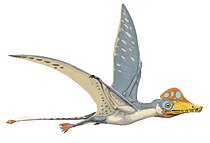Pteranodontoidea: Difference between revisions
other genera existed since the Valanginian stage Tags: Mobile edit Mobile web edit Advanced mobile edit |
m fossil range is approximate, so better put it like that |
||
| Line 1: | Line 1: | ||
{{Automatic taxobox |
{{Automatic taxobox |
||
| name = Pteranodontoids |
| name = Pteranodontoids |
||
| fossil_range = [[Early Cretaceous|Early]]-[[Late Cretaceous]], {{fossil_range|140|66}} |
| fossil_range = [[Early Cretaceous|Early]]-[[Late Cretaceous]], <br>~{{fossil_range|140|66}} |
||
| image = Tropeognathus.JPG |
| image = Tropeognathus.JPG |
||
| image_caption = Skull of ''[[Tropeognathus mesembrinus]]'' |
| image_caption = Skull of ''[[Tropeognathus mesembrinus]]'' |
||
Revision as of 19:26, 15 May 2020
| Pteranodontoids | |
|---|---|

| |
| Skull of Tropeognathus mesembrinus | |
| Scientific classification | |
| Domain: | Eukaryota |
| Kingdom: | Animalia |
| Phylum: | Chordata |
| Order: | †Pterosauria |
| Suborder: | †Pterodactyloidea |
| Clade: | †Ornithocheiroidea |
| Clade: | †Pteranodontoidea Kellner, 1996 |
| Subgroups | |
| Synonyms | |
| |
Pteranodontoidea is an extinct clade of ornithocheiroid pterosaurs from the Early Cretaceous to the Late Cretaceous (early Valanginian to late Maastrichtian stages) of Asia, Africa, Europe, North America and South America.[2] It was named by Alexander Wilhelm Armin Kellner in 1996. In 2003, Kellner defined the clade as a node-based taxon consisting of the last common ancestor of Anhanguera, Pteranodon and all its descendants. Ornithocheiroidea is sometimes considered to be the senior synonym of Pteranodontoidea, however its depends on it definition. Ornithocheiroidea was originally defined as an apomorphy-based taxon by Christopher Bennett in 1994. Later, Kellner (2003) redefined it to represent the node of Anhanguera, Pteranodon, Quetzalcoatlus and Dsungaripterus.[3] Later, David Unwin (2003) suggested a different definition, the node that contains Pteranodon longiceps and Istiodactylus latidens, thus making Pteranodontoidea a junior synonym of Ornithocheiroidea.[4] Brian Andres (2008, 2010, 2014) in his analyses, converts Ornithocheiroidea using the definition of Kellner (2003) to avoid this synonymy.[5]
Classification
Below is a cladogram showing the results of a phylogenetic analysis presented by Andres & Myers, 2013.[6] For alternate cladograms, see List of pterosaur classifications.
References
- ^ Federico L. Agnolin and David Varricchio (2012). "Systematic reinterpretation of Piksi barbarulna Varricchio, 2002 from the Two Medicine Formation (Upper Cretaceous) of Western USA (Montana) as a pterosaur rather than a bird" (PDF). Geodiversitas. 34 (4): 883–894. doi:10.5252/g2012n4a10.
- ^ Richard J. Butler, Stephen L. Brusatte, Brian B. Andres and Roger B. J. Benson (2012). "How do geological sampling biases affect studies of morphological evolution in deep time? A case study of the Pterosauria (Reptilia: Archosauria)". Evolution. 66 (1): 147–162. doi:10.1111/j.1558-5646.2011.01415.x. PMID 22220871.
{{cite journal}}: CS1 maint: multiple names: authors list (link) - ^ Kellner, A. W. A., (2003): Pterosaur phylogeny and comments on the evolutionary history of the group. pp. 105-137. — in Buffetaut, E. & Mazin, J.-M., (eds.): Evolution and Palaeobiology of Pterosaurs. Geological Society of London, Special Publications 217, London, 1-347
- ^ Unwin, D. M., (2003): On the phylogeny and evolutionary history of pterosaurs. pp. 139-190. — in Buffetaut, E. & Mazin, J.-M., (eds.): Evolution and Palaeobiology of Pterosaurs. Geological Society of London, Special Publications 217, London, 1-347
- ^ Andres, Brian Blake (2014). Systematics of the Pterosauria. Yale University. p. 366. A preview that shows the cladogram without clade names
- ^ Andres, B.; Myers, T. S. (2013). "Lone Star Pterosaurs". Earth and Environmental Science Transactions of the Royal Society of Edinburgh. 103 (3–4): 383–398. doi:10.1017/S1755691013000303.












